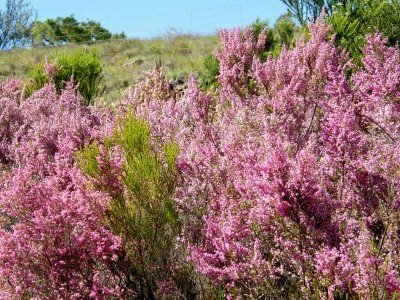| << Chapter < Page | Chapter >> Page > |
The coastal rhenosterbosveldveld type is found on the lowlands along the coast on shale and granite, from sea level to 400 m above. As a veld type, it is rich in a wide variety of speciesand dominated by the rhenosterbush and the characteristic wealth of spring flowers.

(Source from http://www.itmonline.org/image/honey1.gif)

(Source from http://4.bp.blogspot.com/_Dt7LueKRwF0/SduqKc1ZUPI/AAAAAAAABQ0/CgbnLf8LYX8/s400/2 009_03290148.jpg )
ACTIVITY: Read the passage below.
The astonishing richness and diversity of the Western Cape’s natural resources is matched only by the resourcefulness and diversity of its manypeople. Historical patterns of unsustainable use of resources have led to the Cape Floristic Region (CFR) being listed as one of the world’s threatenedbioregions, and the scars are deeply etched in the land and its people.
Now the people of the Western Cape are exploring new and sustainable ways to value and benefit from these globally important assets.
South Africa’s Cape Floristic region is legendary, and the unique nature of the fynbos biome has been celebrated by biologists, conservationists, development experts, and ecologist worldwide.
(Adapted from speech by Tasneem Essop the Western Cape Provincial Minister for Environment, Planning and Economic Development)
Write an essay on the ‘Fynbos’ biome and discuss the following aspects.
Your essay may be written or typed . Marks will be awarded for originality and own interpretation. Include a bibliography of three of more resources. No marks will be awarded for plagiarism.
Factual info : 5x5 (25)
Synthesis: (5)
Total: 30
The thicket biome occurs along the coasts of KwaZulu Natal and the Eastern Cape. Most thickets occur in river valleys. Thickets develop in areas where therainfall is fairly high however; there may be dry periods that prevent the vegetation from developing into forests. The vegetation of this biome includesshort tress, low intertwining shrubs and vines. There are no distinct layers of trees and shrubs with many large open spaces as found in the forest biome.

Thickets in the Eastern Cape are comprised of dense impenetrable vegetation dominated by spiny, often succulent trees and shrubs such as seen in thisphotograph taken near Uitenhage, E.Cape.
(Source from http://www.plantzafrica.com/vegetation/thicket.htm )
The Desert Biome is found largely as the Namib Desert along the coast of Namibia. The Deserts are dry areas where evaporation usually exceedsprecipitation. Rainfall is low -- less than 25 centimeters per year -- and can be highly variable and seasonal. The low humidity results in temperatureextremes between day and night. Deserts can be hot or cold. Hot deserts (e.g. the Namib and Kalahari) are very hot in the summer and have relatively hightemperatures throughout the year and have seasonal rainfall. This combination of low rainfall and high temperatures keeps the air very dry, increasing itsevaporating power. Deserts have relatively little vegetation and the substrate consists mostly of sand, gravel or rocks. The transition regions betweendeserts and grasslands are sometimes called semi-arid deserts.

Notification Switch
Would you like to follow the 'Siyavula: life sciences grade 10' conversation and receive update notifications?